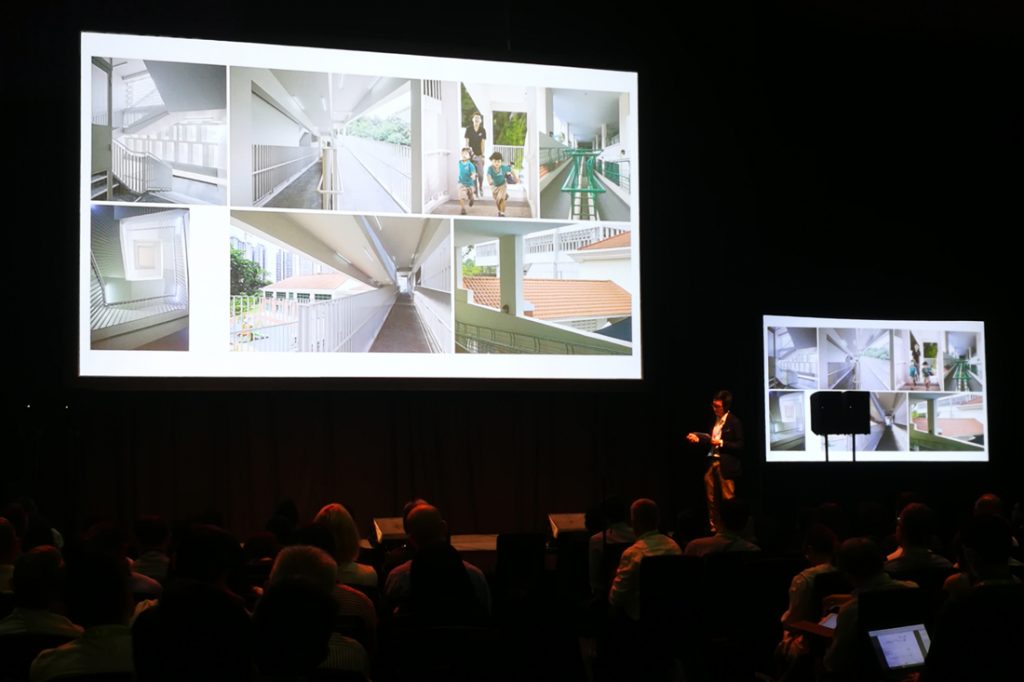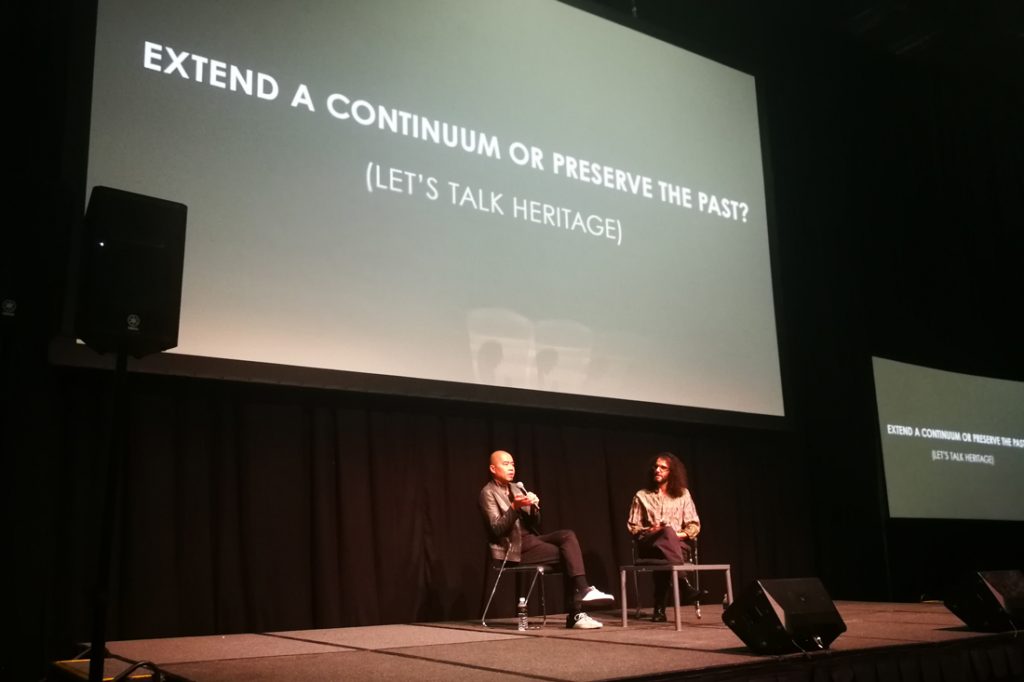Architects addressed the fundamentals of their creative efforts at this year’s Singapore Institute of Architects (SIA) Conference, held during Archifest.

Archifest Festival Director Yann Follain with Dam Vu, Anh Duc Nguyen, Budi Pradono, Siew Man Kok, Doan Thanh Ha, Victor Lee, Gerard Lico, Teo Yee Chin and Manuel Der Hagopian
October 12th, 2018
What are the needs and challenges of our time and how does architecture respond and be responsible towards them? People, time, environment and life were the main themes around which speakers presented their work and ideas at the Singapore Institute of Architects Conference (SIA Conference), held on 2 October at the Marina Bay Sands Singapore Expo & Convention Centre as part of Archifest.
The one-day forum was organised in four themed sessions and was opened by speaker Borja Ferrater of Office of Architecture in Barcelona. In the first session, ‘Design For People’, Đàm Vũ of Ho Chi Minh City-based practice KIENTRUC O talked about creating “functional architecture that inspires the human heart”. This is explored in user-centric design, such as at the Chuon Chuon Kim Kindergarten in the creation of safe spaces that encourage children to explore spatially, and in T House, where the aim is “provoking emotional interactions with the architecture” and creating new connections between the private home, the neighbourhood and the community.

Victor Lee of Plystudio Architects
Victor Lee of Singapore based Plystudio Architects was next on stage to highlight the idea of creating everyday, non-spectacular architecture that is honest in expression and respectful of costs. Lee shared projects including the sheltered link-bridge for National Junior College. He said, “Design for people is embodied in architecture as a function of the needs of people.” He also underlined how designing with people is a crucial aspect of architectural practice, in that built outcomes are co-creations with clients, planning authorities, and other stakeholders. This was the case for the special-education institution Rainbow Centre School in Singapore, where negotiation and the precise calculation of allocated spaces crucially affected cost for various funding parties.
Realrich Sjarief of Jakarta-based RAW Architecture began his presentation by introducing concepts from Javanese philosophy, including that of memayu hayuning bawana – the duty of human beings to make the world beautiful and peaceful. Sjarief sees himself as experimental architect-builder: “If we want to change the world,” he said, “we have to change ourselves first… it is about [figuring out] how to make the impossible possible. We have to celebrate architecture with our failures as an architect.” The Guild in West Jakarta, a remarkable compound on which Sjarief has experimentally built his home and studio space, a clinic and a public library, is a case in point.

Colin Seah of Ministry of Design and Archifest Festival Director Yann Follain
The ‘Design For Time’ session began with Colin Seah of Singapore-based Ministry of Design taking the stage with Archifest Festival Director Yann Follain to discuss the topic of heritage and conservation. Seah views heritage as a continuum – “not a frozen moment in the past, but a continuum of it,” he said. “There is a need to be aware of the past but not overly so, to know the continuum or trajectory of the heritage but also to question what is relevant for today and to find the overlap with yesterday.”
On the controversial subject of en bloc sale and the redevelopment of certain buildings in Singapore, Seah shared: “Every city or country needs to have layers of time. These buildings are likely going to go. The big question is, ‘Is that the right move?’ Perhaps this is too divisive a way to think about it. What could a sensitive move be? I found that maybe there are different models, which are not either pure conservation or demolition, based on a series of value judgments – a way to find hybrid ways to use old structure in relevant new ways.”
In sharing about the ongoing restoration project of the Metropolitan Theatre in Manila, Gerard Lico, heritage architect and Professor at the University of the Philippines, highlighted the importance of instilling a sense of ownership and civic pride for built heritage, and the power in activating a community in restorative and conservation efforts. He concluded his talk with the emphatic statement that “architecture is all too often imagined as if it does not and should not change, but change it does and has always done.”
Wrapping up the session was Teo Yee Chin, Principal of Singapore-based Red Bean Architects and Chief Editor of The Singapore Architect magazine. Teo is of the opinion that “the city is a built record of times passed”. He said, “To work in the city is to work with the archive of human stories. How do we make sure that a building remains implicated with the city – intertwined and inseparable? It is really about the connections this building has to the city.” Teo cited passages and overlapping spaces as some examples of these vital connections.
Look out for part 2 of our SIA Conference coverage next week!
A searchable and comprehensive guide for specifying leading products and their suppliers
Keep up to date with the latest and greatest from our industry BFF's!

Savage Design’s approach to understanding the relationship between design concepts and user experience, particularly with metalwork, transcends traditional boundaries, blending timeless craftsmanship with digital innovation to create enduring elegance in objects, furnishings, and door furniture.

Suitable for applications ranging from schools and retail outlets to computer rooms and X-ray suites, Palettone comes in two varieties and a choice of more than fifty colours.

Channelling the enchanting ambience of the Caffè Greco in Rome, Budapest’s historic Gerbeaud, and Grossi Florentino in Melbourne, Ross Didier’s new collection evokes the designer’s affinity for café experience, while delivering refined seating for contemporary hospitality interiors.

In the pursuit of an uplifting synergy between the inner world and the surrounding environment, internationally acclaimed Interior Architect and Designer Lorena Gaxiola transform the vibration of the auspicious number ‘8’ into mesmerising artistry alongside the Feltex design team, brought to you by GH Commercial.

The Regional Architecture Association (RAA) is planning something big for regional New South Wales! MiCRO kicks off in March, but not before a lead-up online event on 21st February.

Following his recent keynote speech at the 2023 Australian Architecture Conference, we spoke to architect Kevin Carmody about his inspirations and experience.
The internet never sleeps! Here's the stuff you might have missed

Artificial intelligence is one of the defining issues of our time. Here are five ideas articles addressing the anxieties and possibilities of the technology in design.

An entry by MuseLAB, in The Retail Space in the 2024 INDE.Awards, takes shoppers to another planet where diamonds and great interior design make a lasting impression.